|
|
|
Sort Order |
|
|
|
Items / Page
|
|
|
|
|
|
|
| Srl | Item |
| 1 |
ID:
169165
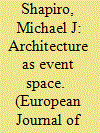

|
|
|
|
|
| Summary/Abstract |
Central to the conception of this article is the architectural theorist Bernard Tschumi's dictum, ‘There is no architecture without action, no architecture without events, no architecture without program … no architecture without violence.’ Shaped as well by Eyal Weizman's conception of ‘forensic architecture’, the focus of the investigation is on Israel's architecture of security and on the corresponding Palestinian architecture of resistance. Emphasising an encounter of cartographies that reveals the way Palestinians make life livable in response to the architectural violence they face, the analysis continues with reference to Yari Sharif's analysis of architectures of resistance and with a reading of a feature film, Hany Abu-Assad's Omar (2013) in which the Separation Wall between Israel and Palestine is one of the film's primary agent/protagonists. The article surveys popular culture texts, focused on crime and espionage to analyse a range of security practices and breaches that amplify the analysis with attention to security issues in individual households, multiple-person dwelling arrangements, architectural locations throughout cities, and buildings housing governmental security agencies. That trajectory of architectural sites lends a micropolitical analysis to the macropolitical level of governmental policy and modes of resistance to it.
|
|
|
|
|
|
|
|
|
|
|
|
|
|
|
|
| 2 |
ID:
169164
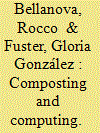

|
|
|
|
|
| Summary/Abstract |
Making sense of digital security practice requires grasping how data are put to use to compose the governing of individuals. Data need to be understood in their becoming, and in their becoming something across diverse practices. To do this, we suggest embracing two conceptual tropes that jointly articulate the being together of, and in, data compositions: composting and computing. With composting, we approach data as lively entities, and we explore the decaying and recycling processes inside Big Data security. With computing, we approach data as embodied and embodying elements, and we unpack the surveillance of ‘asylum speakers’. Together, composting and computing challenge recurrent images of data. Our conceptual composition takes sound as a necessary sensory counterpoint to popular data visions, notably in light of Ryoji Ikeda's artworks.
|
|
|
|
|
|
|
|
|
|
|
|
|
|
|
|
| 3 |
ID:
169162
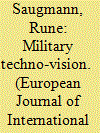

|
|
|
|
|
| Summary/Abstract |
Military applications of technologies for enhancing or producing vision play a key role in composing contemporary security, as such technologies are deployed to make security sense of everyday sociality, of battlefields, and of much in between these extremes. In this article, I set out to recompose militarised techno-vision through the public detritus left by its heterogenous development, use, and appropriation. I argue that as an heterogenous and amalgamated object, military techno-vision can be composed by speaking the stories of its leftovers, and that this composition is characterised by and in turn characterises a longstanding dilemma between fact and vision – between the ambiguity that is constitutive of the human practices of visual perception and image-making, and the desire for machines that can produce visual ‘actionable intelligence’ that can underpin security decisions. Discourses, practices, and regimes of visibility are deployed alongside technologies to occlude the ambiguity of technological vision and sustain the imaginary of technologically altered vision as neutral production of military or security facts.
|
|
|
|
|
|
|
|
|
|
|
|
|
|
|
|
| 4 |
ID:
169166
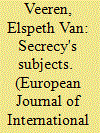

|
|
|
|
|
| Summary/Abstract |
This article sets out a framework for studying the power of secrecy in security discourses. To date, the interplay between secrecy and security has been explored within security studies most often through a framing of secrecy and security as a ‘balancing’ act, where secrecy and revelation are binary opposites, and excesses of either produce insecurity. Increasingly, however, the co-constitutive relationship between secrecy and security is the subject of scholarly explorations. Drawing on ‘secrecy studies’, using the US ‘shadow war’ as an empirical case study, and conducting a close reading of a set of key memoirs associated with the rising practice of ‘manhunting’ in the Global War on Terrorism (GWoT), this article makes the case that to understand the complex workings of power within a security discourse, the political work of secrecy as a multilayered composition of practices (geospatial, technical, cultural, and spectacular) needs to be analysed. In particular, these layers result in the production and centring of several secrecy subjects that help to reproduce the logic of the GWoT and the hierarchies of gender, race, and sex within and beyond special operator communities (‘insider’, ‘stealthy’, ‘quiet’, and ‘alluring’ subjects) as essential to the security discourse of the US ‘shadow war’.
|
|
|
|
|
|
|
|
|
|
|
|
|
|
|
|
| 5 |
ID:
169160
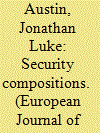

|
|
|
|
|
| Summary/Abstract |
This article argues that security politics is constituted through the ways in which its contours are ‘made sensible’ (perceivable to our senses) through material, aesthetic, or affective mechanisms. To make this argument, the article introduces the theoretical scaffolding for what it terms a compositional ontology. A compositional approach to security identifies, theorises, and studies the perceptual base of security politics in order to ask how – say – the sight of a single photograph, sound of a security announcement, or smell of tear gas, can frequently be the direct (efficient) cause of international security policy, discourse, and decision. To theorise the deep political impact of such fleeting moments of local sensory experience, the article lays out a compositional ontology comprised of a synthesis of poststructuralist and new-realist philosophy, as well as the empirical sensibilities of pragmatist sociology. Combined with a focus on sensibility, it is shown that these approaches can produce an ontology of security that more effectively explains contingency, fluidity, and change in world politics. Having laid out the theoretical frame for a compositional ontology, the article discusses its political and methodological implications, suggesting it demands that security studies shift towards a more postcritical, experimental, and collaborative ethos.
|
|
|
|
|
|
|
|
|
|
|
|
|
|
|
|
| 6 |
ID:
169163
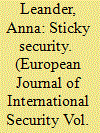

|
|
|
|
|
| Summary/Abstract |
In security studies and beyond, technological developments are associated with technocratic, rationalistic, transparent forms of security governed from a distance. In much of the advertising of tracking devices the associations made are very different not to say opposed to this. The advertising composes security anchored in sensemaking and resonance rather than calculus and reason, working from within and below rather than from a above at distance and depending on the negotiation of opaque co-presences rather than the establishment of precision and transparency. The consequence is that advertising not only extends but also deepens the grip of military/security matters: making them sticky. Moreover, the heterogeneity of the elements is such that what is composed is a shifting collage rather than a stable composition. This argument makes a threefold contribution to security studies: a theoretical reconceptualisation of what it means to compose security, an empirical intervention in the debates surrounding the politics of tracking devices and a methodological intervention in favour of collaborationist research strategies.
|
|
|
|
|
|
|
|
|
|
|
|
|
|
|
|
| 7 |
ID:
169161


|
|
|
|
|
| Summary/Abstract |
The purpose of this article is to introduce and explore the political potential of visual autoethnography. I do so through my experience of working as a Swiss Army officer in the Korean Demilitarized Zone (DMZ). Drawing on my own photographs I examine how an appreciation of everyday aesthetic sensibilities can open up new ways of thinking about security dilemmas. I argue that visual autoethnography can be insightful not because it offers better or even authentic views – it cannot – but because it has the potential to reveal how prevailing political discourses are so widely rehearsed and accepted that we no longer see their partial, political, and often problematic nature. I illustrate this potential in two ways: (1) how a self-reflective engagement with my own photographs of the DMZ reveals the deeply entrenched role of militarised masculinities; (2) how my positionality and my photographs of everyday life in North Korea show that prevailing security discourses are highly particular and biased, even though they are used to justify seemingly objective policy decisions.
|
|
|
|
|
|
|
|
|
|
|
|
|
|
|
|
|
|
|
|
|